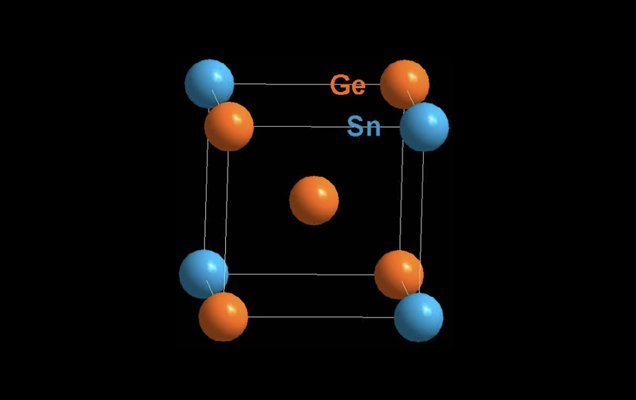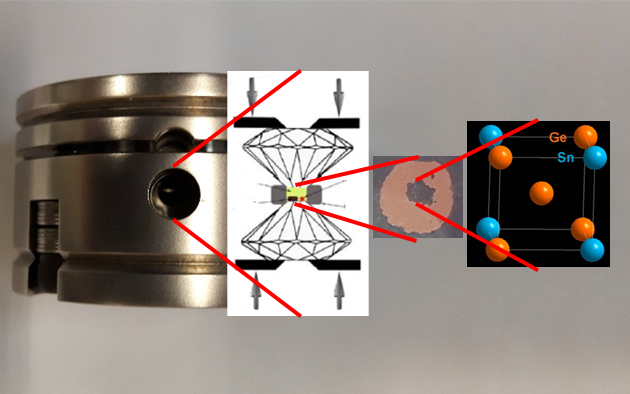The elements carbon (C), silicon (Si), germanium (Ge) and tin (Sn) play an outstanding role in future oriented technologies from micro- and nanoelectronics to optics and opto-electronics. Si and Ge are important classical semiconductor materials. While silicon is an irreplaceable component in micro-chips, it has proven inefficient for opto-electronic applications such as lasers, LEDs, or photo detectors. This is one of the reasons for the search for alternative materials to improve the conversion of electrical energy into light. Solid solutions containing two (or more) elements offer the advantage of adjusting crystal structure and (opto)electronic properties to suit the specific needs for the respective application. One way to synthesize these new materials is to vary pressure and temperature during the production process. A promising material in this field is GeSn.
High pressure devices
In the framework of an international cooperation, George Serghiou of the University of Edinburgh, UK and Hans-Josef Reichmann of the German Research Center for Geosciences (GFZ), Potsdam with colleagues at the University of Edinburgh, the Deutsches Elektronensynchrotron (DESY), Hamburg and the European Synchrotron Radiation Facility (ESRF), Grenoble present a new approach to synthesize GeSn by utilizing high pressure devices resulting in a simple cubic structure of the GeSn alloy. This work has been published recently in the journal Angewandte Chemie International Edition.
Germanium and tin are reluctant to form a solid solution because they exhibit different crystal structures, lattice parameters or atomic radii at ambient condition (1 bar). Thus, GeSn solid solutions have been produced only in a few hundred nanometers thick layers using deposition methods. The scientists here applied technologies which are mainly used in geosciences: Very high pressures and temperatures can be generated in diamond anvil cells and multi-anvil apparatii. These enable scientists to simulate conditions in the lab similar to those of the inner Earth. A multi-anvil apparatus squeezes millimeter sized samples by means of hard metal anvils, a diamond anvil cell produces the pressure by pressing micrometer sized samples between two diamonds. As the diamonds are transparent in a wide energy range, an infrared laser beam has been used to heat the Ge-Sn mixture in the sample chamber.
Unususal GeSn alloy
In this manner the scientists subjected the starting Ge-Sn mixture to huge pressures up to 28 Gigapascal (280.000 times the atmospheric pressure) and temperatures up to 580 degrees Celsius. These experiments resulted in an unexpected new GeSn alloy with cubic symmetry (Im-3m space group).
Live view of the crystal growth
The scientists could follow in-situ the formation of the novel crystal: both high pressure methods allow the sample to be probed with X-ray beams. The synchrotron sources at DESY in Hamburg and at ESRF in Grenoble provide extremely powerful X-ray radiation making it thus possible to study the reactions towards and the structure of the new alloy.
Creating new materials without the need to follow conventional criteria and routes to synthesis
“Several unusual aspects are associated with the synthesis and structure of this new group IVA cubic alloy,” the scientists say. Among other things, Ge and Sn have unlike crystal structures and different atomic radii in the examined pressure range. However, similar atomic radii and crystal structures are essential for the creation of solid solutions. Another unusual aspect is, that melting is unfavorable in this formation process, although melting usually facilitates the homogenization, reactivity and crystal formation. While the newly synthesized material is not stable at 1 bar (ambient pressure), it transforms at 1 bar to further materials with possible optoelectronic potential. The scientists underline that these results open up fertile avenues facilitated here by high pressure and temperature, to synthesize potential new functional materials without being restricted by ‘traditional’ formation criteria. This is especially crucial when it comes to important classes of materials like semi-conductors or semimetals. (ud)
Original publication: George Serghiou, Hans Josef Reichmann, Nicholas Odling, Kristina Spektor, Anna Pakhomova, Wilson A. Crichton, and Zuzana Konôpková: An Unexpected Cubic Symmetry in Group IV Alloys Prepared Using Pressure and Temperature, Angew.Chem. Int. Ed. 2021, 60,9009–9014, DOI: 10.1002/anie.202016179
Scientific contact:
Dr. Hans-Josef Reichmann
Chemistry and Physics of Earth Materials
Helmholtz Centre Potsdam
GFZ German Research Centre for Geosciences
Telegrafenberg
14473 Potsdam
Phone: +49 331 288-1416
Email: hans-josef.reichmann@gfz-potsdam.de










![[Translate to English:] Torsten Sachs in front of a climate station on a field](/fileadmin/_processed_/3/9/csm__TorstenSachs_bearbeitet_GS_4a1365ef84.jpeg)

![[Translate to English:] left image flood at the Ahrtal: image from above, several houses are flooded; left image:: Heidi Kreibich;](/fileadmin/_processed_/4/4/csm_Bild2_9af0130e9f.png)



![[Translate to English:] Start der Vega Rakete](/fileadmin/_processed_/6/4/csm_20231201-kachel_Vega-VV23-launch_ESA-CNES-Arianespace_706716b68c.jpeg)









![[Translate to English:] Poster exhibition at the Brandenburg Hydrogen Day at the GFZ, some participants in the foreground](/fileadmin/_processed_/6/5/csm_Erster_Brandenburgischer_Wasserstofftag_GFZ_402fcec95e.jpeg)
![[Translate to English:] Group picture of the participants](/fileadmin/_processed_/9/4/csm_20231108_CAWa-Workshop-Tashkent_Gruppenbild_99ea779d8a.jpeg)

![[Translate to English:] [Translate to English:] Hörsaal](/fileadmin/_processed_/e/6/csm_H%C3%B6rsal_e21ac645fb.jpeg)


![[Translate to English:] The Delegations in the Historic Library on the Telegrafenberg. In the back there are from left to right, the Dutch Ambassador for Germany, Ronald van Roeden, the Dutch Minister for Education, Culture and Science, Robbert Dijkgraaf and the scientific director of the GFZ, Susanne Buiter.](/fileadmin/_processed_/d/b/csm_Kachel-2_9eba4b4212.jpeg)

